
The following is advice for selecting a tennis racquet. Similar applies to selecting racquets for other sports. For more detailed information seek the advice of a qualified coach.
- Tennis Racquet Grip Size: A correct grip size is important to avoid injury around the elbow and wrist
- Head Size: The size of racquet head will depend on your playing standard.
- An oversize racquet is more suitable for beginners as it allows fewer miss-hits, more spin to be put on the ball and greater power in the shot.
- Mid-sized racquets are used by more accomplished players.
- The smaller head size offers more manoeuvrability and stability, but needs the player to generate more power.
- Racquet Weight and Materials:
- Graphite and Aluminium are light but provide good power and control, hence suitable for beginners.
- Boron or Kevlar racquets very light, but stiffer - so transfer shot vibrations to the arm - and are mostly used by advanced players.
- Weight Balance: Baseline players prefer “head heavy” racquets while players at the net and who volley prefer "handle-heavy" racquets.
"Handle-heavy" racquets are easier on the arm and offer greater control, but the player has to be able to generate more power and spin, and so making it most suitable for experienced players with higher skills
- Racquet Length: the greater length the greater the leverage and hence more power in the shot.
- Beam Width: The beam is the width of the head of the racquet. A wider beam gives more power to a shot but will reduce control over the ball.
- String Tension
- Most racquets come pre-strung with strings in mid tension.
- Tighter strings give more shot control, spin and accuracy.
- Looser strings mean more power but less control.
- More experienced players tend to play with high string tension for better control.
- Natural gut string is more forgiving on the tissues.
- Swing Speed:
- Beginners have a "slower, shorter" swing profile and need a racquet with more power (rebound).
- Stronger players have a "faster, longer" swing and need a "control" racquet.
- Dampers can be used to absorb vibration and reduce shock to the wrist and elbow. Back to Top
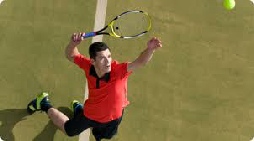
Racquet Sports place a number of demands on the body and these must be trained for.
Each sport is different - in terms of equipment used, ball size and movement and shot execution – but there are similarities too: use racquet in one hand, general movement patterns and skill / agility / speed.
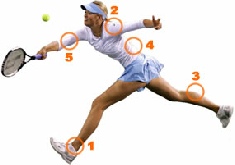
A good training programme includes flexibility, core stability, muscle strength + endurance, plyometrics, balance and agility and sport specific work.
It is preferable to train in a standing position and to use all planes of motion.
Games can last up to 2-3 hours so require good cardiovascular endurance for optimal performance requiring aerobic training for 30 - 60 minutes.
The dynamic stop-start nature of the sports requires short periods of high-intensity work using the anaerobic energy system which is trained with higher-intensity speed work – HIIT.
Muscle endurance is necessary for racquet sports – training that includes total body conditioning, core and flexibility training.
Racquet Sports require explosive responsiveness with precision + control. Maximal strength, power, muscle endurance, agility, speed, co-ordination, balance and neuromuscular control in all planes of motion are needed to perform well and avoid injury.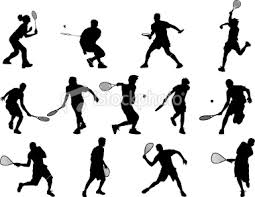
Racquet sports involve the use of a racquet in one hand. These could also other sports such as table tennis which use the same movement patterns and skills.
Racqu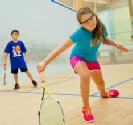 et Sports are practiced by a wide cross section of society, including the younger + older player, the recreational player and the elite professional player.
et Sports are practiced by a wide cross section of society, including the younger + older player, the recreational player and the elite professional player.
The use of a racquet (or bat), gripped in one hand, which is swung to strike a ball towards the opponent’s side of the court or field.
There is a vast choice of racquets to choose from and each sport has its own particular skill set. All sports involve a of rapid changes of direction and short sharp movements of the limbs - which require agility, core stability, flexibility and movement control.
Each sport uses a court with different surfaces and may be enclosed within a confined space.
Correct grip size = from the middle crease of your palm to the tip of your ring or middle finger.
Hold the racquet in one hand and place the index finger of the other hand along the handle between the tips of
your fingers and the palm.
If there isn't enough room for your index finger, the racquet grip is too small.
If there is a lot of extra room, the racquet grip is too large.
If you're between two sizes, choose the smaller one; you can always increase the circumference by adding grip tape.
The most common injuries are sprains and strains of the ankle, knee, wrist, elbow, and rotator cuff.
Many racquet sport inju ries are due to overuse or overloading at the shoulder, elbow, or wrist of the dominant arm.
ries are due to overuse or overloading at the shoulder, elbow, or wrist of the dominant arm.
Poor posture & muscle imbalances cause compensatory movement patterns to develop and can lead to overuse injuries, particularly at the shoulder or elbow.

Ankle sprains are among the most common injuries of the lower limbs, associated with trying to decelerate rapidly during lateral movement.
Racquet sports injuries were distributed among squash (59%), tennis (21%) and badminton (20%). The higher squash injuries is probably due to higher physical stress and risk of contact in this sport.
Injuries were more prevalent in persons over 25 years (59%) i.e. the reverse for sport in general.
Squash players were prone to acute traumatic injuries, with the majority affecting the knee, lumbar region and ankle.
Tennis players presented most commonly with muscle strains and ligament sprains secondary to overuse. They regularly present with lateral epicondylitis, patello-femoral pain and prolapsed lumber disc
‘Tennis elbow’ is caused by overloading of the forearm muscles + tendons due to faulty backhand technique – poor body position with elbow leading the racquet, late strokes and "wristy" impacts.
There are particular risks for young players because they begin playing with a lower level of physical conditioning. Lower limb injuries are twice as common as those of the upper limb or spine in young players, with ankle injuries being the most common
Lower limb injuries predominated in all three sports.
Many injuries occurred in new, infrequent or social players. Poor warm-up was a common factor among new and established players.
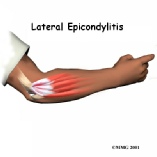 Injuries are more sports specific than gender specific. However gender differences may account for some variations - injuries to the abdomen, back, and groin were significantly fewer in female players, females had more injuries to the foot, leg, calf, and wrist whereas males sustained more injuries to the ankle, groin, and hand and more contusions, abrasions, and lacerations.
Injuries are more sports specific than gender specific. However gender differences may account for some variations - injuries to the abdomen, back, and groin were significantly fewer in female players, females had more injuries to the foot, leg, calf, and wrist whereas males sustained more injuries to the ankle, groin, and hand and more contusions, abrasions, and lacerations.
If you sustain an injury while playing racquet sports or feel you are not playing at maximum performance allow us to assess the situation for you and develop a rehabilitation programme for you. To contact us click here
Tennis Elbow
USTA Strength Training
Common Muscle Imbalances
Common muscle imbalances are seen in racquet sports players.
Muscles that are commonly tight and need to be stretched include: hip flexors, quads, pectorals and anterior shoulder girdle, calf, wrist flexors, and lats.
Muscles that are commonly weak and need to be strengthened include: trunk stabilizers such as spinal erectors and abdominals, posterior shoulder girdle and scapular stabilizers, rotator cuff, gluts, hamstrings, wrist extensors, and hip abductors and adductors.
The racquet arm is used more than the non-dominant arm and muscle / motion imbalances can develop between right + left and back + front of the body. Correcting imbalances will improve performance and to prevent injury.
Current approaches emphasise a dynamic warm up + stretching and a some static stretching within the warm down routine.
The US Tennis Association have a good section on sports science and training which can be accessed by clicking here
Here is an example of elite players warming up and down - but it is in table tennis! The principles apply across many sports and include aerobic (running) dynamic and static stretching.
Typically modern approaches dictates an emphasis on dynamic exercise is during warm up and a some more static stretching within the warm down routine. This video does not include the sport specific drills part of warm up which would normally follow on from the general exercise routines.
USTA Warm Up Programme Back to Top
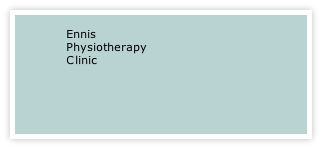




Mon - Fri 9.30am - 8.30pm


3A Barrack Close, Barrack St., Ennis, Co. Clare V95 X437

065 6840757
| Health+Safety Services |
| Sports Clubs+Teams Services |
| Standing Posture |
| Sitting Posture |
| Childhood Posture |
| Using Portable Devices |
| Normal Walking |
| Running |
| Running Drills Videos |
| Muscle Energetics |
| General Fitness |
| Losing Body Weight |
| Gaining Body Weight |
| Weight Loss Programmes |
| Start to Run |
| Start to Swim |
| Start Cycling |
| Start Nordic Waliking |
| Rehab of Tensdons |
| Loading of Tendons |
| Non Specific LBP |
| Posture |
| Intervertebral Disc |
| LBP Treatment |
| Non Specific Neck Pain |
| Neck Care Advice |
| Hamstring Strain |
| Ankle Sprain |
| ACL Injury |
| Joint Replacement |
| Shoulder Dislocation |
| Tennis Elbow |
| Wrist fracture |
| Fractured Knuckle |
| Selecting a Racquet |
| Racquet Grip Size |
| Racuet Sport Injuries |
| Training for Racquet Sports |
| Ski + Board Injuries |
| Injury Videos |
| Injury Prevention |
| Preventing Injury in Musicians |
| Irish Dancing |
| Preventing Dance Injury |